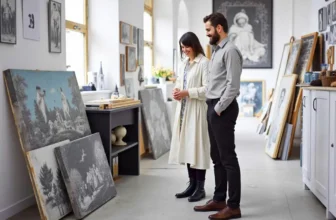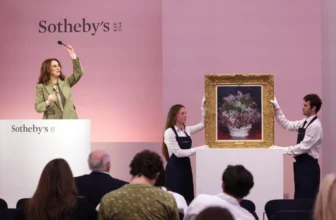
Wealth, Identity and the Psychology Behind Collecting Art
| Invest in Hidden Masterpiece: Rare Antique Oil Paintings For Sale. Limited Originals Available 💰😊 Are you looking for authentic hidden masterpiece? Explore old master antique oil paintings from the Renaissance and Baroque eras. From 16th-century portraits to 18th-century landscapes. Authenticity guaranteed, Old Master antique oil paintings for sale. Shop Now! 🎨 Renaissance And Baroque Art Landscape Antique Paintings Old Master Portrait Paintings |
Owning historical art has long been associated with power, taste, intellectual depth, and a distinct psychological profile. Across centuries, art collecting has served as a signal of status, a financial strategy, and a symbolic extension of the self. Today, in an era defined by digital noise and rapid consumerism, historical artworks carry even more weight, offering cultural capital, emotional resonance, and often extraordinary financial returns.
This article provides a deep, SEO-optimized exploration of what your ownership of historical art communicates about you, how art can contribute to wealth, how your collection reflects your personality, and the psychology behind why individuals buy art in the first place.
Owning Historical Art as a Social and Cultural Signal
1. You Possess a High Level of Cultural Literacy
Historical art ownership communicates that you engage with the intellectual and aesthetic heritage of humanity. Unlike mass-produced decorative items, historical art requires, at least implicitly, knowledge of movements, time periods, techniques, symbolism, or provenance.
Owning such works signals that you value:
Cultural continuity
Historical awareness
Intellectual curiosity
Engagement with artistic discourse
In social and professional contexts, historical art functions as a subtle marker of sophistication. It signals that you understand the cultural narratives that shape civilizations and that you participate in preserving them.
2. You Appreciate Legacy Over Trends
Historical art is, by definition, not contemporary. Owning it communicates that you prioritize:
Timelessness
Heritage
Permanence
Long-horizon thinking
Collectors of historical art often see themselves as custodians, not just owners. This stewardship mindset aligns with attributes such as strategic thinking, patience, and a desire to conserve things with lasting value.
3. You Are Comfortable With Complexity
Historical art, whether Renaissance paintings, tribal masks, classical sculpture, or ancient manuscripts, comes with layers of meaning. Acquiring such work implies that you are comfortable engaging with:
Symbolism
Cultural context
Political histories
Religious influences
Shifting aesthetic conventions
Possessing historical art signals intellectual depth and an appreciation for complexity in ideas, aesthetics, and human stories.
How Owning Art Makes You Wealthy
The intersection of art and wealth is not new; it dates back to antiquity. But the modern art market increasingly functions like an asset class, offering unique financial and psychological advantages.
1. Art as an Appreciating Asset
Historically, blue-chip artworks have demonstrated consistent appreciation over time. While not as liquid as stocks or bonds, fine art shows characteristics of a store of value asset. Key features include:
Non-correlation with traditional markets (art often retains value during economic downturns)
Rarity-driven price growth
Strong performance in long-horizon portfolios
High demand for museum-caliber works
Historical art often amplifies these features because scarcity is absolute, no new 17th-century Dutch paintings or ancient African bronzes can be produced.
2. Art as Wealth Preservation
High-net-worth individuals frequently use art to diversify and protect wealth. Historical art provides a hedge against:
Inflation
Currency fluctuation
Market volatility
Systemic risk
Unlike fiat currency, art’s intrinsic value is not tied to government or corporate stability.
3. Art as Collateral
Financial institutions increasingly allow collectors to borrow against art holdings. This liquidity transformation means that well-chosen historical artworks can unlock capital while remaining in your possession. Such lending is particularly popular among:
Family offices
Private equity principals
Entrepreneurs
Multi-generational wealth holders
Art-backed loans allow wealth to remain productive without divesting assets.
4. Tax Optimization Opportunities
Depending on jurisdiction, art can support wealth strategies through:
Charitable donation deductions
Estate planning structures
Deferred capital gains
Strategic gifting
Historical art, due to its museum relevance, is often particularly beneficial for charitable donation models.
5. Social and Professional Leverage
Art collecting opens doors that enhance long-term wealth creation. High-end art events, auctions, foundations, and museum boards provide exclusive networking access. These environments generate:
Business partnerships
Investment opportunities
Reputation enhancement
Thought leadership credibility
In elite networks, cultural capital often translates directly into economic opportunities.
How Art Reflects Your Personality
Art collections act as psychological mirrors. Even when collectors claim purely financial motives, choices still reflect internal preferences, needs, or narratives.
1. Your Aesthetic Preferences Reveal Cognitive Patterns
Preference for particular styles or eras reflects certain psychological tendencies:
Classical realism → appreciates order, tradition, structure
Abstract expressionism → values emotion, spontaneity, introspection
Surrealism → gravitates toward imagination, subconscious exploration
Impressionism → drawn to transience, atmosphere, sensory experience
Ancient or tribal art → deeply curious about origins, heritage, anthropology
Historical art specifically reflects an orientation toward continuity and contextual depth.
2. Your Collection Shows How You See Yourself
Art often serves as an extension of identity. Owners may gravitate toward works that reflect:
Personal history
Cultural affiliation
Existential themes
Intellectual interests
Moral values
A person who acquires powerful historical portraits may identify with leadership; someone drawn to ancient religious iconography may resonate with spirituality or transcendence.
3. Your Art Reveals Your Tolerance for Ambiguity
People who embrace ambiguous, symbolic, or historically dense works tend to:
Be more open to new experiences
Enjoy multiple interpretive layers
Possess higher cognitive flexibility
Conversely, those who prefer clear narrative realism often value coherence and stability.
4. The Scale of Your Collection Reveals Your Orientation Toward Abundance
Large collections imply:
Energetic curiosity
A desire to build archives
Enthusiasm for creative ecosystems
Motivation to expand personal cultural influence
Smaller, curated collections emphasize intentionality, restraint, and conceptual precision.
The Psychology of Buying Art
Understanding the motivations behind art acquisition requires integrating behavioral economics, consumer psychology, and aesthetic theory.
1. The Need for Identity Construction
One of the strongest motivations in art buying is identity formation. Collectors use art to:
Signal who they are
Explore who they want to become
Construct a cultural or intellectual persona
Anchor personal narratives
Historical art, because it is embedded in cultural time, helps collectors connect themselves to larger human stories.
2. Emotional Regulation
Art generates emotional states. Buyers select works that:
Soothe or ground them
Energize or inspire
Provide nostalgia
Reflect internal conflicts
Express suppressed feelings
Collectors often form deep emotional bonds with pieces, making art one of the most psychologically resonant forms of ownership.
3. The Desire for Beauty or Sublimity
Human beings are wired to seek aesthetic stimulation. Art satisfies:
Sensory pleasure
Pattern recognition
Novelty seeking
A search for meaning
Desire for transcendence
Historical artworks often intensify this experience due to their craftsmanship and symbolic gravitas.
4. Social Status and Prestige
Art remains a potent status symbol. Drivers include:
The allure of exclusivity
The desire to signal wealth indirectly
Membership in elite circles
Awareness of social perception
However, prestige-driven collectors often evolve toward deeper motivations as their knowledge grows.
5. Investment Rationality
A significant subset of collectors approaches art with financial discipline. Motivations include:
Portfolio diversification
Inflation hedging
Tax strategy
Asset appreciation
Yet even financially motivated buyers tend to develop emotional and intellectual connections with artworks over time.
6. The Dopamine Reward of the “Hunt”
The acquisition process, the research, auction tension, rarity discovery, activates reward pathways in the brain. Buyers experience:
Anticipation
Competition
Victory
Ownership gratification
This “collector’s high” reinforces long-term collecting behavior.
7. Cognitive Dissonance and Justification
Once a collector acquires a work, they typically increase their perceived value of it, a psychological phenomenon known as the endowment effect. This deepens attachment and long-term retention.
What Owning Historical Art Ultimately Says About You
Historical art ownership reveals a unique profile that blends aesthetics, psychology, economics, and identity. It communicates that you are:
A curator of cultural memory
An investor with long-term vision
A person who prioritizes depth and context
Someone who resonates with legacy, narrative, and craftsmanship
An individual capable of complex emotional and intellectual engagement
It signals that you see yourself as part of the continuum of history, and that you participate in shaping cultural heritage rather than merely consuming it.
Art as Wealth, Identity, and Psychological Expression
To outsiders, art might seem like decoration. In reality, it is one of the most psychologically rich, financially sophisticated, and personally expressive forms of ownership available. Historical art in particular communicates refinement, strategic thinking, and a profound connection to human culture.
Owning historical art makes you wealthy, not just financially but intellectually, socially, and emotionally. It reflects your personality by externalizing your values, aesthetics, and worldview. And the psychology of buying art reveals deep human motivations: identity, emotion, prestige, curiosity, and desire for meaning.
To own historical art is to participate in an ancient dialogue, a conversation between creator, viewer, culture, and time.




